|
I can only assume this fence is to stop children playing on the slides from being hit by children on the swings. Are we getting overprotective? Isn't common sense developed by trial and error and the occasional scrape? Or am I missing something here?
0 Comments
This walk was an uneventful expedition into the quiet neighborhood of Pinebrook. Despite being wedged between busy thoroughfares (County Road 125 aka Weaver Street; Quaker Ridge Road; Pine Brook Boulevard; and the Hutchinson River Parkway) and providing a cut through between Weaver and Pine Brook Boulevard, the neighborhood was very quiet. Almost disturbingly so for a middle of summer Saturday although it may have been because it was a hot day. No children out playing, not even in the playground which was partially shaded by trees and just a few people out walking dogs. Most in evidence were landscapers hard at work. No sidewalks! Not a great surprise. From what I have been able to find out this area was built in the 1950s, a time when cars were on the increase and shared use neighborhoods were still a thing of the future. This is very clearly a single use residential area of single family homes of moderate size, now with some new much bigger homes pushing up against its Southern boundary. It does have a playground, and trees although some were not looking happy. Split canopies caused by utility pruning were very obvious. The pruning work is contracted by the utility companies to standard clearance specifications. Interestingly, some years ago in Los Angeles we saw many wires in sleeves allowing trees to grow more naturally and in closer proximity to utility lines. For some reason this has not caught on here in New York. Looking at all these divided canopies naturally led to discussion about putting utilities underground. Not an easy task considering how rocky much of Westchester is as can be seen by the rooting of the tree below. 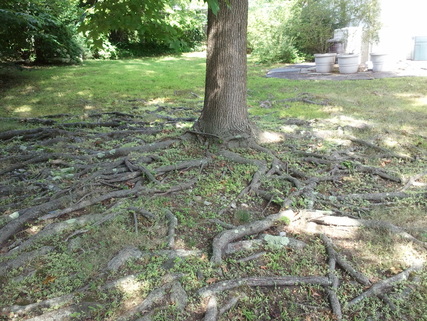 If you can't go down...go out! The point of this entry however was not supposed to be about trees, but rather what would happen to our informal noticeboards if utilities went underground? Take a look around your local neighborhood and check out all the ways utility poles are used. I don't yet know who owns the utility poles in New Rochelle and what agreements are made between utility companies and councils but it seems that whoever owns these poles could be missing an opportunity to rent them as advertising space.
No, there is no cash machine inside this bank on our street. If you're on foot, you line up with the cars. And no, I'm not singling out Chase, there are other banks that do the same.
To the gentleman doing his banking: my apologies. I wasn't stalking you or trying to get your cash, I just wanted a photo of the facilities and you being there made it perfect. 'Walk All Streets' Walk Four on August 14, 2013 took us past one of my pet pedestrian peeves. Roadworks. Specifically road works where solutions to keep motorized traffic moving have been carefully included as part of the works BUT the same has not been done to keep pedestrians moving efficiently nor safely. Below is a picture of some long term works on Main Street near the Home Depot. This is a busy area because of the entries/exits to the I-95 and also buses are routed past here. Note the pedestrian crossing on the far right in the photo that ends in a road works barrier. At this point, a pedestrian wanting to continue along Main towards the city center has three choices. 1. Walk along the edge of the roadworks, highly dangerous because the open lane in the photo is a turning lane. 2. Follow the directions (not visible in the photo) to follow the sidewalk to the right and cross lower down and means taking the time to walk three blocks instead of one. Also dangerous because the sidewalk only continues in the wrong direction and four lanes of road must be crossed to then walk without a sidewalk. 3. Turn left and cross four lanes of traffic to reach the sidewalk on the other side of Main. Also dangerous. Here's the same road works from the other side showing clearly why walking along the edge of the works is NOT a good idea. What is good is that a brand new sidewalk can be spotted between the two cars in the foreground. Shame it is still behind a fence. And here are the walking conditions if the instructions to pedestrians are followed and pedestrians turn right to find their way around the works. Conclusion? Difficult and dangerous whatever option is chosen and that's for able bodied people. If you have mobility issues, don't even attempt it. It is my opinion that any plan approved for road works must contain adequate pedestrian options so people are not dumped into traffic. The sign found at the end of a street on this same walk, sums it up well.
Here's a great article from Planners Web about Dr. Richard Jackson, MD, MPH titled A Call to Action....And to Walking.
The map showing the increase in diabetes is not good new news. Neither is the statistic that for ages 3 to 34 the leading cause of death is vehicle crashes. If a disease was responsible for a similar number of deaths annually it would be considered as epidemic but for some reason we tolerate car crashes as if they are a necessary evil. So how many deaths are we talking about? According to the US Department of Transportation, in 2011 there were 32,367 traffic fatalities (excluding any occurring on private property - parking lots, driveways etc.). Of these 4,432 were pedestrians. The good news (if anything around this statistic can be called good) is that the total number of traffic fatalities has decreased from 43,005 in 2002. The bad news is that while pedestrian deaths have also declined over the same time period from 4851 in 2002, the percentage of pedestrian deaths has risen from 11 to 14. Does this mean more miles are being covered on foot thus creating more opportunities for getting run over? Or is it getting more dangerous to be a pedestrian? Whatever the case, we are killing over 32,000 people in this country per year on our roads. That's a LOT of avoidable deaths and I fully support the switch in terminology from 'accidents' to 'crashes'. While very few people deliberately use their vehicle as a weapon these crashes happen because of driver error or vehicle failure. Most are driver error so keep that in mind next time you reach for your phone while driving. Walk Three August 11, 2013. The theme of this walk turned out to be Urban Green We walked from New Rochelle's boundary with Pelham Manor along Pelham Road and up Weyman exploring all the side streets along the way and then back to Pelham Manor via Rockledge, Hillcrest and Mt Tom. Our big discovery was Donofrio Memorial Park! Tucked away at the end of MorganStreet behind the Home Depot and Costco it looks desperately underutilized and included the tree below, used to chain off an area and developing an unhealthily nipped in waist. So let's talk trees. Some cities are recognizing trees are assets but many more still regard them primarily as an expense and a liability. There are reasons for viewing trees as problems - they need to be maintained and sometimes they fall over or drop branches and can cause loss of life and/or property damage. For these reasons trees are more likely to show up on a city's insurance policy for their potential to do harm than on a city's asset register acknowledging their benefits. This in turn colors the importance, or lack of, placed on city trees when developing annual budgets often leading to inadequate funding for maintenance, planting, succession planning and administering tree ordinances and permitting systems. Happily at least some cities are beginning to realize the value of trees in their communities. Mesquite, Texas undertook an Urban Forest Ecosystem Analysis in 2012 and determined that their trees were worth 996 million dollars. Here's a few things Mesquite's Online News had to say. "Most of the trees in the city are less than 6 inches in diameter but they provide the removal of 288 tons of pollution each year, store 145,000 tons of carbon and produce 31,900 tons of oxygen. The trees also provide building energy savings of $773,000 a year and approximately $2 million a year in savings through annual rainfall interception." Mesquite has close to double the population of New Rochelle and covers 42.2 square miles to New Rochelle's 10.67 but it leaves me wondering about the worth of New Rochelle's trees and whether the city includes them in their accounting beyond the expense of maintenance of city owned trees. Fayetteville in Arkansas completed an Urban Forest Ecosystem Analysis in 2002 and followed it with a Tree Canopy Assessment in 2012. Here's a short summary of findings: "- Overall Tree Canopy Cover: Fayetteville has 36% urban tree canopy cover based on 2010 imagery. - Net Gain/Loss in tree canopy: Fayetteville had a net loss of approximately 1.5% UTC since 2002. - Stormwater value: Fayetteville's tree canopy is valued at an estimated $64 million based on avoided stormwater facility construction costs. - Air pollution benefits: Fayetteville's urban forest removes nearly 1.3 million pounds of air pollutants from the air annually, which is valued at $3.5 million per year." Not mentioned here is the cooling and shade provided by trees in the summer. A USDA Forest Service 2013 research abstract notes that: The greater Kansas City region's trees are estimated to reduce annual residential energy costs by $14.0 million per year. The compensatory value of the trees is estimated at $93.4 billion. Cities can use trees, vines and other vegetation to cool parking lots, streets and buildings, reducing urban heat gains by 40 - 80% according to the Washington State Department's Tree Link News. All great news for pedestrians walking on paved surfaces in the summer sunshine. Trees also have a positive impact on house values which flows through to property taxes thus impacting a city's income. Way back in 1980 the Journal of Arboriculture published an article stating that property values were 6% higher when they had good tree cover. More recent studies support these findings. Not only do trees on personal property increase property values, streets with street trees also increase property value. In acknowledgement of the importance of urban green some cities have strict permitting systems for the removal of trees based on factors such as size, species, condition and/or location. I checked New Rochelle's website and didn't find anything about permits for private trees but did see this: "Residents may remove a street tree themselves after first obtaining the written permission from the City and payment of the $25 fee. Residents who wish to remove a tree will be required to replace the tree. The tree removal company which is contracted to provide the service must remove and dispose of the tree in its entirety including the stump. The contractor must also provide a Certificate of Insurance to the City." I have not yet contacted the city forester to ask him about the permitting and accounting treatment of trees within New Rochelle so will say no more about the regulations until I am better informed but between the city website and the 2012 Financial Report I see no evidence that our city trees have been valued nor listed as assets. If I find out I am wrong about this I will correct my post, happily! On our third Walk All Streets adventure we enjoyed the shade provided by street trees but noted some poor planting and maintenance practices - a concern because selection, planting, maintenance and regular inspection all play a role in the safety of trees. It was disheartening to read on New Rochelle's website that: "Trees requiring some action on the part of the City are placed on a list to be addressed as staffing and funding becomes available for such work. The volume of work can exceed the funds available in any particular fiscal year." 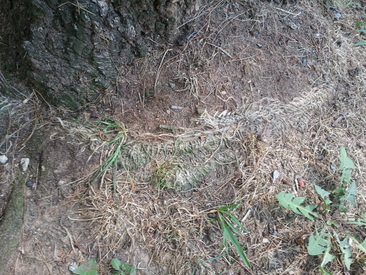 This is at the base of a pear tree, one in a row along Pelham Road planted maybe 10 years ago judging by their size...(a guess). As can be seen, the trees were balled and burlapped and this photo shows that the tree was planted still in its wrapping. Some landscapers say that this is good practice because it stops the root ball from falling apart. The trouble is that the burlap does NOT disintegrate as quickly as most expect. In addition, the burlap often restricts water flow so trees may fail through drying out. Finally, the burlap can restrict the roots leading to more likelihood the tree will have a less well developed root system than one planted free of burlap. Sometimes burlap is treated to be rot resistant just to make things worse. As to needing the burlap to hold the root ball together, healthy root balls do not "fall apart". What falls apart when a tree is unwrapped is severed roots and a lot of loose soil. For more on how to plant a tree, TreeUtah has clear simple instructions.  This is another of the pear trees on Pelham Road. The space the tree has to grow is restricted, the blue nylon string is part of the burlap fastening and has been completely grown over by the tree. In this case the nylon does not appear to be causing trouble but failure to remove fastenings around the stem of a tree can cut through its cambium layer as the tree grows. The cambium layer is a thin layer of cells which divide to create bark on the outer side and wood on the inner. It also produces the xylem and phloem that transport of water, salts and photosynthesized food keeping the tree alive. Cutting through this layer ring barks the tree, killing it. While in the picture the roots have grown around the string which would have been cut to avoid choking the stem the problem here is the girdling of the roots, circling around trying to find space to grow. These roots can themselves choke a tree to death.  So back to our tree in Donofrio Memorial Park. As with the girdling above, once this tree grows to the point that the chain cuts through its cambium layer it will die. So, when you are out walking and you see a tree with a rope, a tape, a chain that is starting to cut into the tree...SET IT FREE! Having said that, we were unable to remove the locked chain on this one. As can be seen, this tree has rot and damage lower down the stem so its future does not look bright. When walking under trees, it is also useful to look up. Partly to enjoy the beauty of the tree canopy and the bird and animal life it contains, but also to look out for broken branches that may be hanging above our heads. These hangers can be killers and are particularly important to watch for after storms. There is much more to be said about trees - pruning practices, succession planning, disease and conditions like summer drop but this post is plenty long already so I'll leave it here for now. 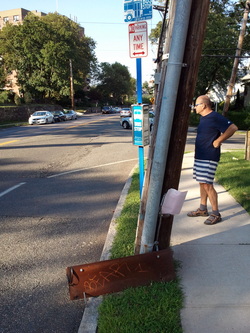 Continuing with the theme of accessibility, walking and access to transport go hand in hand. New Rochelle is blessed with both bus and train routes and Pelham Road, part of our second walk includes a bus route. No coincidence that this area comes second on the walk score - a respectable 77 - of all New Rochelle's neighborhoods. Why there is a metal plate bolted to a lamppost at this bus stop is a mystery to me and seems a potentially damaging obstacle to buses stopping here. Most of the bus stops along this route are without shelters and some, like this one, are also without seating and trash receptacles. Much can be done to make bus stops more interesting and enjoyable. Here's a link that talks about some of the options worth considering. And below are two more stops along the same route we walked past. 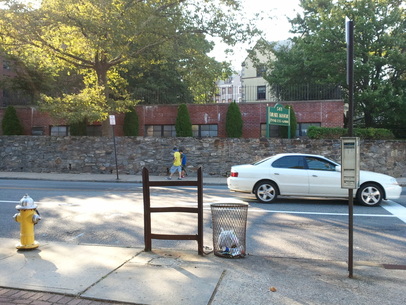 Nice to have a trash receptacle but its placement could be a little more rider friendly. And what is that ladder for??? Firmly set in the concrete, made of metal and one of the many mysteries we are finding on our city streets. Anyone know what it is for? 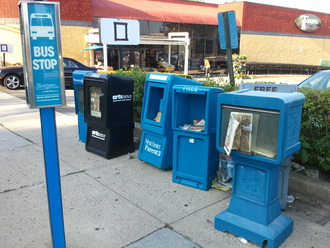 And here's my favorite. The literary bus stop. It's a little crowded and not well cared for but there seems to be a desire to make sure that anyone waiting here (and this bus stop does have a shelter) has something to read while they wait. An additional great feature of New Rochelle buses are the clarity of the schedules on the bus stop signs. They show a map of the route, the route number and the scheduled times. So simple, so clean. In contrast the bus timetables in Cardiff when I was there a couple of years ago were so complex I was completed defeated. I did read...somewhere... about a resident near Cardiff who simplified the timetable for his local route, delivered his version to everyone in his neighborhood and the ridership went up! 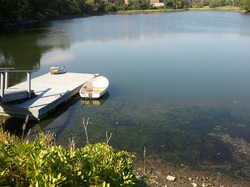 For Day Two of our New Rochelle Walk Every Street Challenge we decided to explore some streets close to home. The photo on the left is of Titus Mill Pond, a tidal pond at the end of an inlet of the Long Island Sound. Our apartment overlooks the pond giving us the views below (taken in the spring and in the late fall respectively). When the leaves fell off the trees last year we were startled by the amount of garbage along the edge of the pond prompting us to consider starting a 'Friends of Titus Mill Pond' to do an annual clean up. Upon inquiry we found out that the pond is privately owned! And that a few years ago there was a proposal to fill it in and build houses on the fill! Having been raised in New Zealand with a great love of the Queen's Chain, imperfect though it is, the idea of someone privately owning the end of an inlet opening onto, ultimately, an ocean had me gobsmacked. Despite this we have not given up the idea of an annual cleanup. The pond is home to many birds including herons and ospreys and they deserve better than a lot of plastic bags and broken toys. So what does all this have to do with walkability? Quite a lot actually because accessibility is such a large part of walkability. Accessibility can be limited by highways, lack of sidewalks, lack of wheelchair access, and, in parts of New Rochelle, lack of access to waterways such as the fence off Titus Mill Pond. Having said that I hasten to add that New Rochelle is blessed with more access to its coastline than many...most?...other settlements along the Westchester shore of Long Island Sound. We have some fabulous parks which I'll cover in later posts but time to get back to our second New Rochelle Challenge walk since that's the title of this entry. For this walk the theme overall was really accessibility - to waterways, to bus routes and to the five senses. 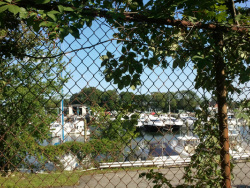 Walk Two included a number of short streets ending at the inlet. We pressed our noses on fences and enjoyed the view while looking at such a perfect potential path running along the inlet towards Glen Island Park. This is not likely to happen due to private ownership, marinas, and various built obstacles but for cities still thinking about how to manage land near waterways I urge them to consider pedestrian and cycle access. It is such a great incentive for locals and visitors alike to get out and walk! Which brings me to the five senses. A young designer, Jinsop Lee gave a TED Talk recently called Design for the Five Senses in which he urged designers to consider all five senses when designing. Someone in a planning forum then asked whether architects and planners should also be considering all five senses and the responses were YES! Much has been written about scented gardens for the visually impaired but how often do we consider scent when designing urban space? Not just flowers but the scents of cafes, restaurants, dumpsters, fish shops, wine bars..... My home town had a city block that for years included a bakery, a fish market, a pub and a florist. The commingling of scents made that block absolutely distinctive. I can't say for sure if it was a completely happy convergence but it became a whiff of home, a scent of place, comforting as well as distinctive. When we create spaces, design streets to encourage walkability, do we really spend enough time thinking about the way it will smell? What about a variety of textures to please our sense of touch? Again this has been considered for the visually impaired with the use of tactile visual curb cuts. But what about increased use of different surfaces, cladding on buildings, innovative street furniture for all of us? Children particularly are highly tactile. How can our street designs encourage a love of walking, a sense of adventure and exploration for our young pedestrians? Along with a sense of safety to encourage nervous parents to let their children out of their strollers and onto their feet! Sight, and sound are more commonly considered but could still do with improvement. People will walk for longer and travel on foot further if their surroundings are interesting. Things to see, explore and where the sounds are pleasing. That leaves taste. Closely linked to smell and ranging from tasting diesel fumes to sea spray to a great cup of coffee. Let's make the five senses accessible through great design! New Rochelle's overall walk score is 69 which translates to "Somewhat Walkable" however our neighborhood is the second highest ranking for all of New Rochelle awith a "very Walkable 77! No wonder we like it!
One of the things that struck us on our first walk of our New Rochelle Walking Challenge was the amount of private parking. A few examples are shown below. These asphalt deserts raise a few questions. How much of the space taken up by private off-street parking has been mandated through the current city zoning codes? What is the run off effect on the city's storm water system of all this paved space? How much of this parking is actually used? We were walking around on a Sunday and acres of parking sat empty. What is the value of the land sitting here underutilized? How much are the owners of these parking lots paying in taxes? And what is the effect of all this parking on walkability? It doesn't make for the most interesting vistas. And much has been said about the safety of areas like these, especially at night with few people around, poor lighting, and no where close to run to in an emergency. Parking is a weirdly emotive topic and one that I will certainly return to while completing our Challenge, including attempting to answer some of the questions I have posed above. In the meantime, for anyone interested and who hasn't already read it, check out Donald Shoup's High Cost of Free Parking Donald Shoup talks of parking spaces as 'land banks' just begging to be put to better use. And if people and cities are determined to keep areas like those in the images above dedicated to parking, he suggests getting creative about multiple leases of space - commuters Monday to Friday during the day, restaurant patrons in the evening, churches and sports clubs on the weekends - ANYTHING to stop so much space sitting vacant so much of the time. What we found during our walk looked to be the opposite of this approach, and seems remarkably unproductive and a sad waste of both space and economic opportunity. And my personal favorite from our Sunday stroll.
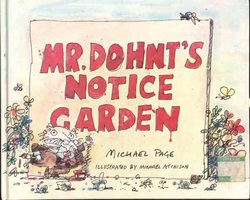 This much loved children's book about Mr Dohnt and his "No Notices" came to mind when our New Rochelle Walking Challenge took us to two cemeteries directly adjacent to one another.  Beechwoods Cemetery may be Mr. Dohnt's final resting place. NO bicycles, NO motorcycles, among other things. But notice what is NOT on the NO list. YES cars! And thankfully YES pedestrians!  During our walk around the cemetery we saw several cars and NO bicycles so perhaps the signs are working. The question is why are bicycles considered so undesirable? Is it assumed all cyclists are children? As can be seen on the notice above, children are also not allowed unless accompanied by an adult. Nice they rank higher than dogs who aren't allowed in at all. Are all cyclists considered troubled souls with a penchant for trick riding on headstones? What has happened here in the past to put them on the excluded list? Answers anyone?  At Holy Sepulchre next door there are far fewer restrictions. Even dogs are allowed as long as you curb them. And best of all, outside of the gate we found.... 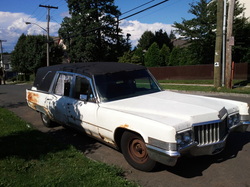 ....this! An old hearse. Finding such a great old vehicle in such a perfect location seemed a fantastic piece of serendipity so we took a closer look. 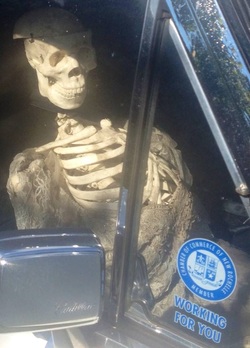 And riding shotgun was the perfect passenger! Not sure what the New Rochelle Chamber of Commerce thinks about sharing the window with her or him. |
Author: Nina ArronI am an enthusiastic pedestrian, urban planner, and project manager currently living in New Rochelle, New York. I am grateful to be living in a walkable city with affordable easily accessible public transport (both trains and buses). My appreciation became even greater after spending three years back in New Zealand where it was much harder to fit daily walking into my life in what is considered one of the great natural, green environments in the world. Archives
February 2019
Categories |
| Urban Afoot |
|
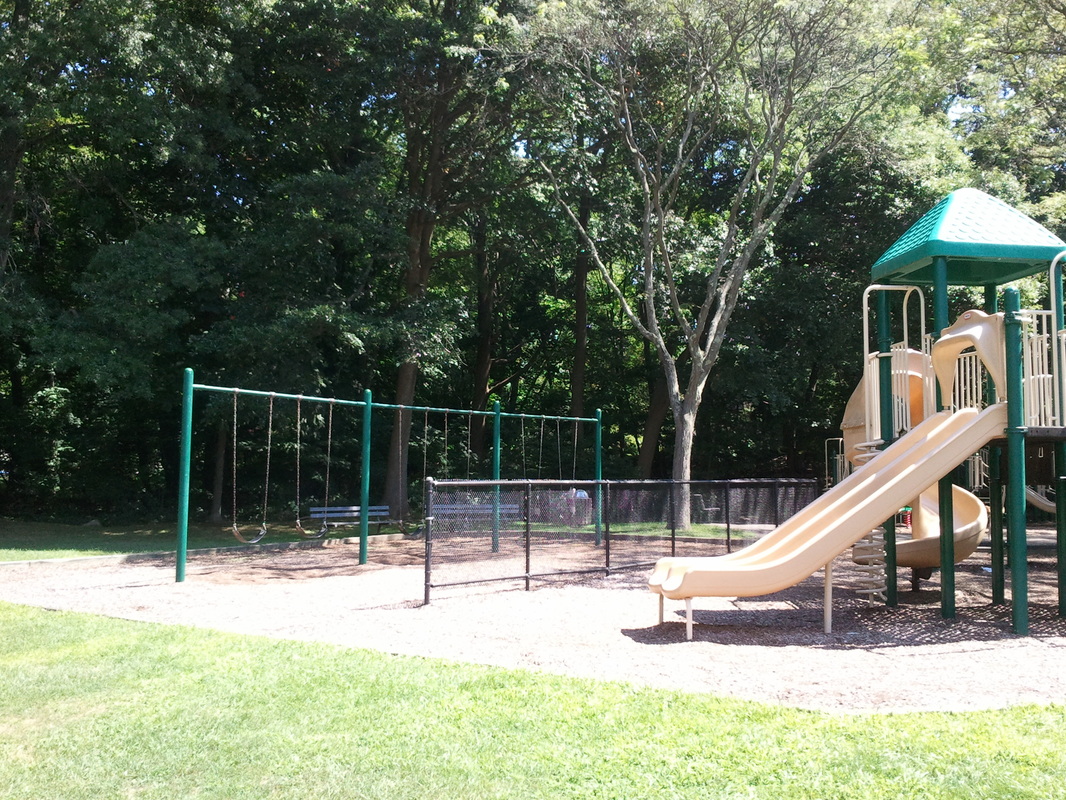
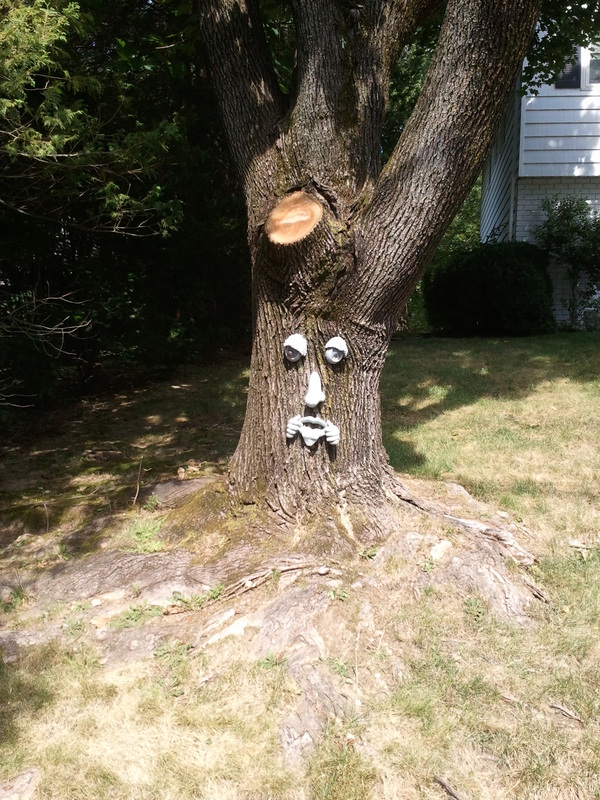

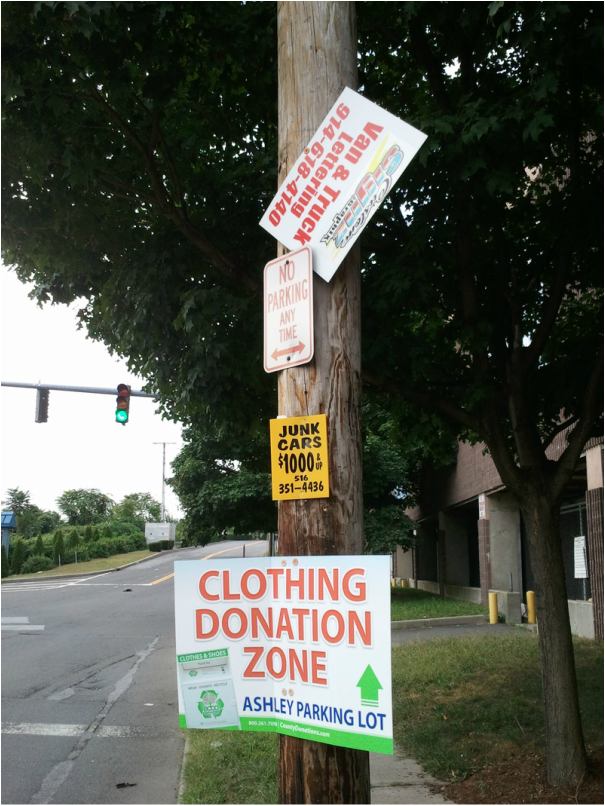

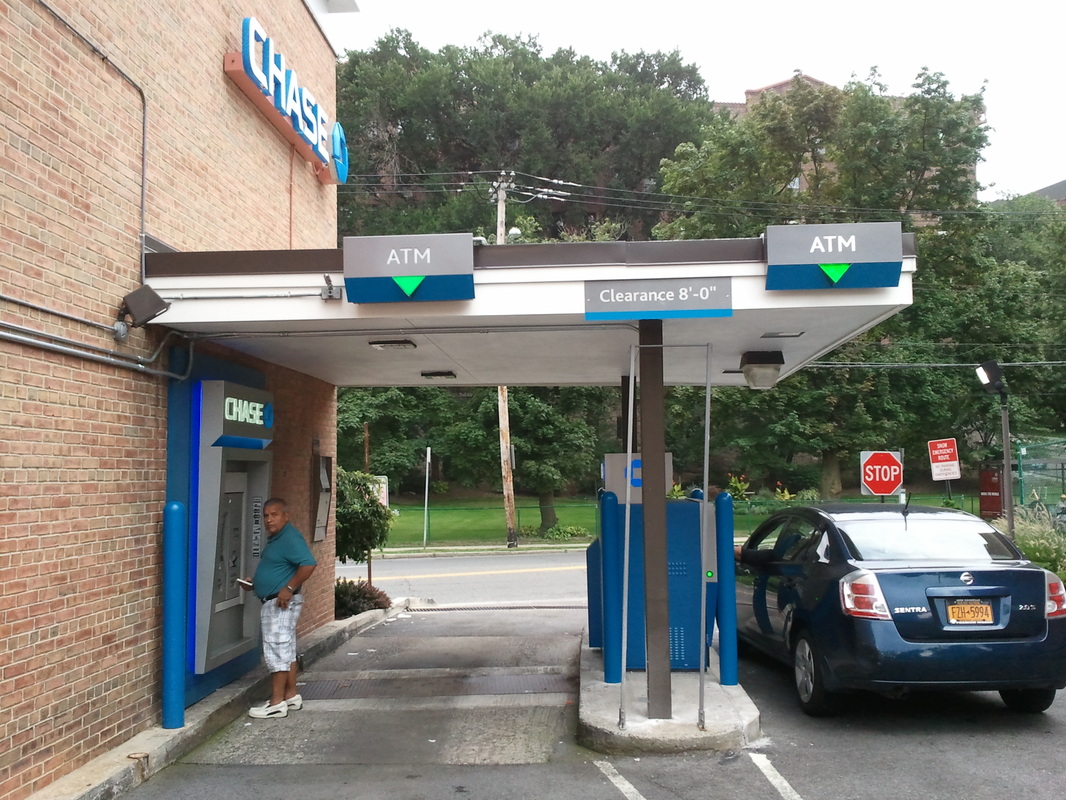
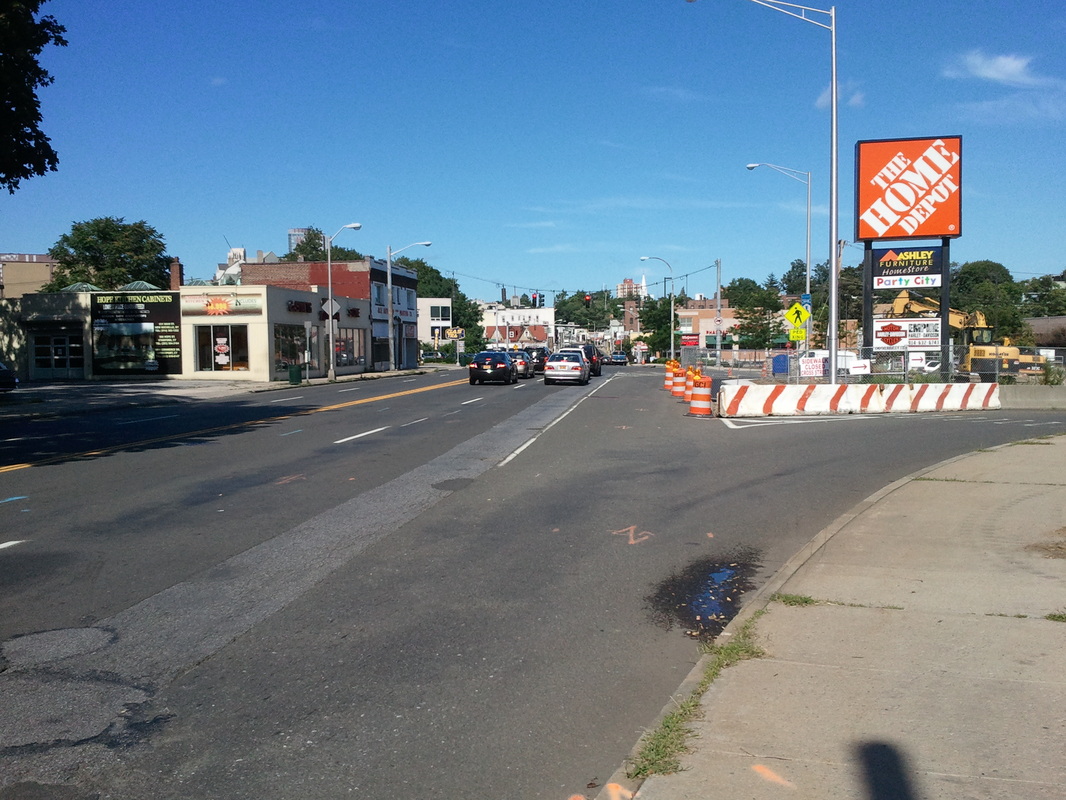

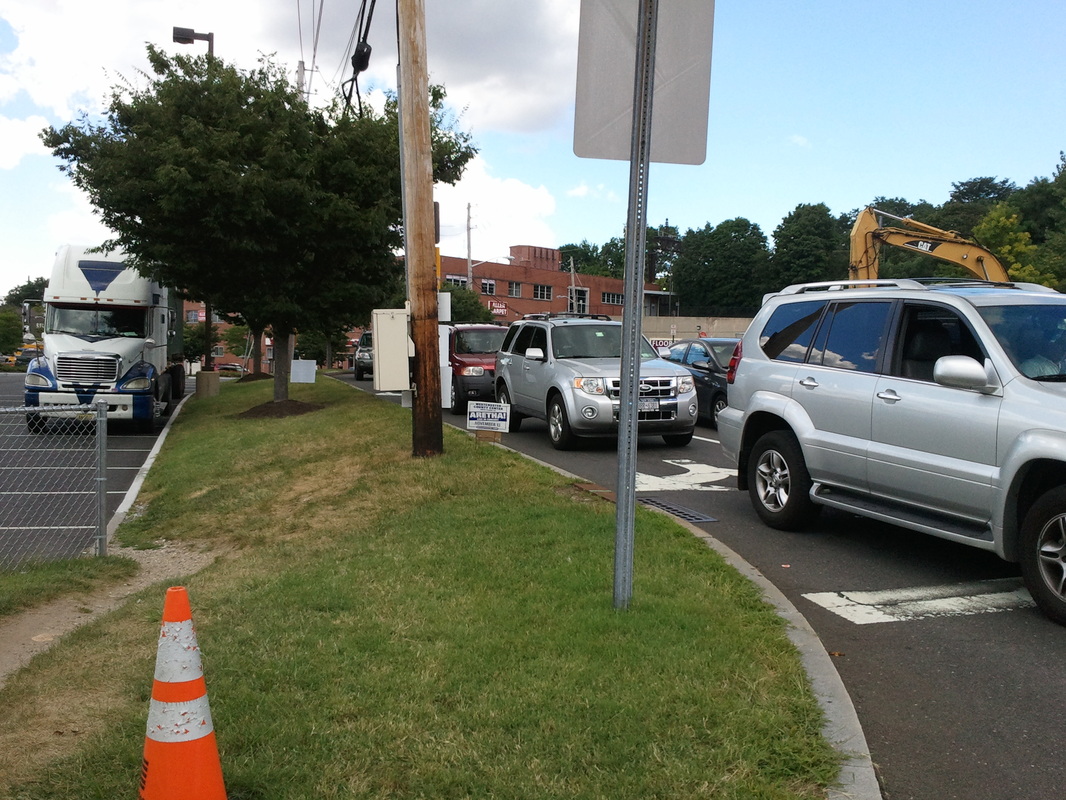


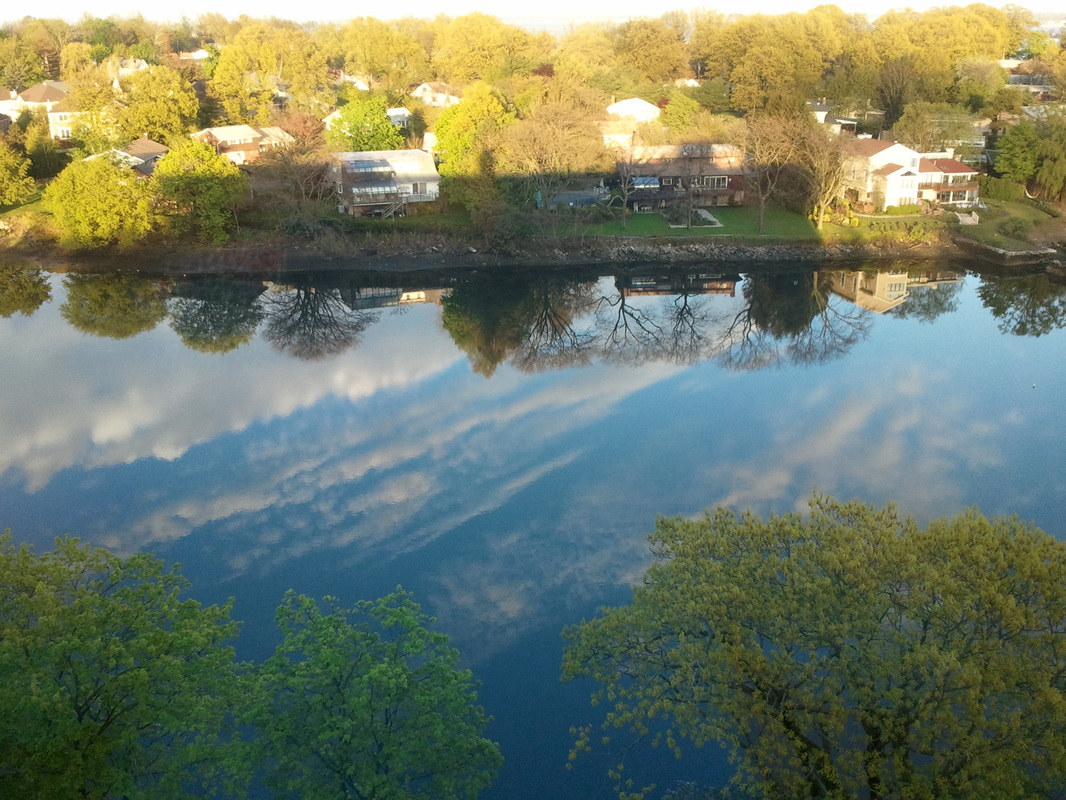
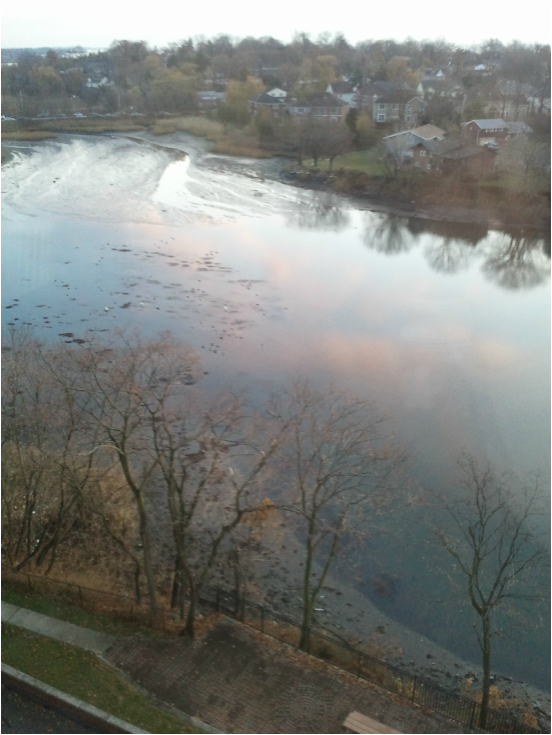

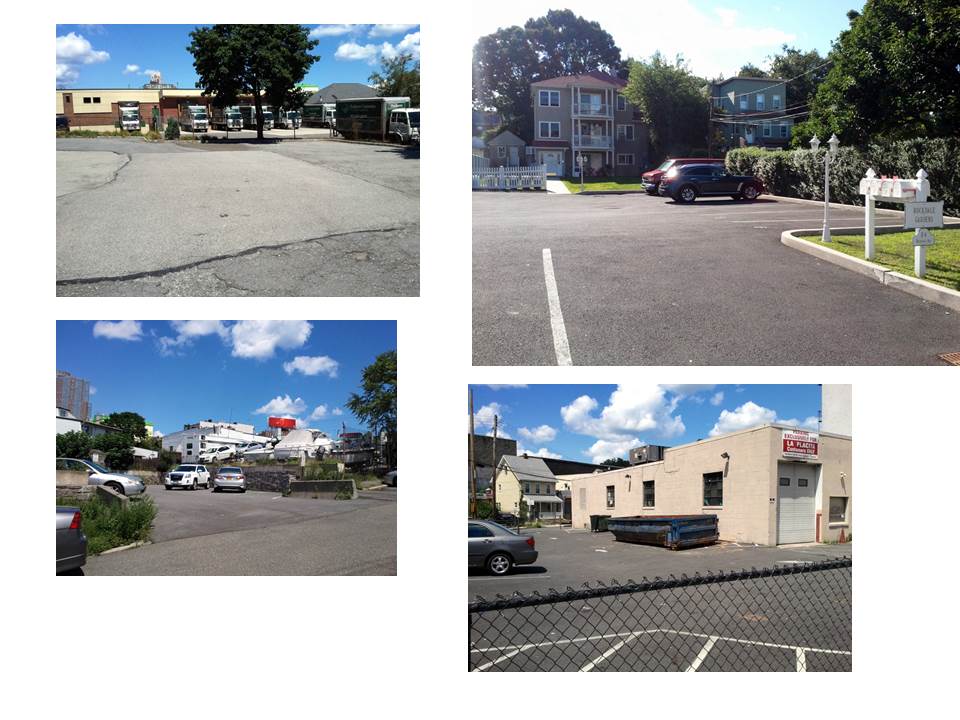


 RSS Feed
RSS Feed
